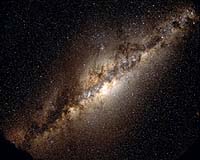|
|
|
Milky Way Not Doomed To Galactic Bombardment Columbus OH (SPX) Sep 01, 2009  As scientists attempt to learn more about how galaxies evolve, an open question has been whether collisions with our dwarf galactic neighbors will one day tear apart the disk of the Milky Way. That grisly fate is unlikely, a new study now suggests. While astronomers know that such collisions have probably occurred in the past, the new computer simulations show that instead of destroying a ... read more
As scientists attempt to learn more about how galaxies evolve, an open question has been whether collisions with our dwarf galactic neighbors will one day tear apart the disk of the Milky Way. That grisly fate is unlikely, a new study now suggests. While astronomers know that such collisions have probably occurred in the past, the new computer simulations show that instead of destroying a ... read moreWarped Debris Disks Around Stars Are Blowin' In The Wind  Greenbelt MD (SPX) Sep 01, 2009
Greenbelt MD (SPX) Sep 01, 2009The dust-filled disks where new planets may be forming around other stars occasionally take on some difficult-to-understand shapes. Now, a team led by John Debes at NASA's Goddard Space Flight Center in Greenbelt, Md., finds that a star's motion through interstellar gas can account for many of them. "The disks contain small comet- or asteroid-like bodies that may grow to form planets," Deb ... more
|
Vietnam says parched Red River at record low
China to be world's third biggest wind power producer: media Cost-cutting NASA eyes three cheap space missions Honduras declares state of emergency amid drought Russia in secret plan to save Earth from asteroid: official Sarkozy scrambles to salvage carbon tax French carbon tax ruled illegal Brazil's Lula signs law cutting CO2 emissions 2009 a 'benign' year of natural disasters: German re-insurer Greenpeace Spain demands Denmark release its director
| |||||||||||||||
| Previous Issues | Aug 31 | Aug 30 | Aug 28 | Aug 27 | Aug 26 |
| . |
Scientists Uncover Solar Cycle, Stratosphere And Ocean Connections Boulder CO (SPX) Sep 01, 2009
Boulder CO (SPX) Sep 01, 2009Subtle connections between the 11-year solar cycle, the stratosphere, and the tropical Pacific Ocean work in sync to generate periodic weather patterns that affect much of the globe, according to research appearing in the journal Science. The study can help scientists get an edge on eventually predicting the intensity of certain climate phenomena, such as the Indian monsoon and tropical Pacific ... more Small Fluctuations In Solar Activity, Large Influence On The Climate  Bonn, Germany (SPX) Sep 01, 2009
Bonn, Germany (SPX) Sep 01, 2009Our sun does not radiate evenly. The best known example of radiation fluctuations is the famous 11-year cycle of sun spots. Nobody denies its influence on the natural climate variability, but climate models have, to-date, not been able to satisfactorily reconstruct its impact on climate activity. Researchers from the USA and from Germany have now, for the first time, successfully simulated ... more Honey, I Blew Up The Tokamak  Huntsville AL (SPX) Sep 01, 2009
Huntsville AL (SPX) Sep 01, 2009Magnetic reconnection could be the Universe's favorite way to make things explode. It operates anywhere magnetic fields pervade space--which is to say almost everywhere. On the sun magnetic reconnection causes solar flares as powerful as a billion atomic bombs. In Earth's atmosphere, it fuels magnetic storms and auroras. In laboratories, it can cause big problems in fusion reactors. It's ... more |
. |
| . |
Death Rays From Space Moffett Field CA (SPX) Aug 28, 2009
Moffett Field CA (SPX) Aug 28, 2009Cosmic rays pour down on Earth like a constant rain. We don't much notice these high-energy particles, but they may have played a role in the evolution of life on our planet. Some of the mass extinctions identified in the fossil record can be linked to an asteroid impact or increased volcanism, but many of the causes of those ancient die-offs are still open for debate. "There may have been ... more Scientists wonder about planet's location  Newcastle-Under-Lyme, England (UPI) Aug 27, 2009
Newcastle-Under-Lyme, England (UPI) Aug 27, 2009 British scientists are trying to determine why a Jupiter-style planet orbiting close to its sun has not spiraled into the star and burned up. Wasp-18b is so close to the star Wasp-18 that it completes its orbit in less than an Earth-length day, astrophysicists at Keele University in Staffordshire say. In an article in Nature, they say standard astronomical theories hold the planet shoul ... more 2009 Comet Awards Announced  Cambridge MA (SPX) Aug 28, 2009
Cambridge MA (SPX) Aug 28, 2009Finding a comet can be a quick way to get some immortal fame - and a little spending money, as well. An annual award of several thousand dollars for discoveries of comets by amateur astronomers has just been announced for five individuals in five different countries. The Central Bureau for Astronomical Telegrams (CBAT) - operated by the Smithsonian Astrophysical Observatory (SAO) in Cambri ... more |
. |
| Previous Issues | Aug 31 | Aug 30 | Aug 28 | Aug 27 | Aug 26 |
| The contents herein, unless otherwise known to be public domain, are Copyright 1995-2009 - SpaceDaily. AFP and UPI Wire Stories are copyright Agence France-Presse and United Press International. ESA Portal Reports are copyright European Space Agency. All NASA sourced material is public domain. Additional copyrights may apply in whole or part to other bona fide parties. Advertising does not imply endorsement, agreement or approval of any opinions, statements or information provided by SpaceDaily on any web page published or hosted by SpaceDaily. Privacy statement |